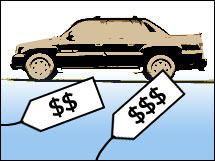7 smart ways to find new customersGet the most from your mailings to potential customers using tips from a direct-marketing pro.(Fortune Small Business) -- What does it take to get someone to buy a car? A personalized letter promising a $1,000 discount can go a long way. That's what I discovered years ago in Canada when I worked on a direct mail campaign for Ford, promoting Lincoln's Town Car, Continental and Mark VIII. We told recipients that all they had to do was visit a dealership, negotiate their best price and then produce the letter to save another $1,000. Sales took off. Consumers are bombarded these days with advertising messages. Direct marketers like me are part of the reason. For 12 years in New York and now in Hollywood, Fla., I have run Mason & Geller Direct (masongeller.com), a direct marketing advertising firm with big clients such as J.P. Morgan Chase (Charts), as well as entrepreneurial firms. Sending an offer by mail can cost anywhere from 50 cents to $150 for each prospect, depending on the different components of the campaign. For the most part, direct mail is more expensive than advertising by e-mail or on the web, but it can also be much more effective in the long run. How do you get the most out of the money you invest in your direct mailings, whether you handle them in-house or hire an outside firm? Here are seven of the approaches I recommend to clients. 1. Save the postcards for vacation. The classic letter in an envelope has a much better chance of generating a significant response, in my experience. To most consumers, serious mail comes in a letter, which is private. The act of opening an envelope and unfolding the letter is engaging. A few years ago my company created a two-page letter for a firm that was selling a $2,000 annual subscription service to advertisers and ad agencies. Our client had done fairly well with a post-card campaign. It was generating paid orders at a rate of about 0.75%. We thought we could do better. We created a letter to the ad agencies that said, "If you can send me an e-mail with the 4 letter code above, I'll send you a secret that will help you land new business you didn't even know was loose." Each recipient had a private code, available only in the letter. Paid response increased to 11%. 2. Impose a deadline. Give recipients a valuable freebie that they can't get any other way than by responding now. It should fit what you are selling. For instance, if you were a tax preparer trying to attract new clients for next year, you might send a mailing in January of 2008 offering the first 100 new customers a free leather binder to store their 2007 taxes - and tell them that the offer would expire on March 15. Potential customers who can't procrastinate will act immediately. 3. Emphasize your product's benefits, not just its features. Say you are selling a teapot with a spill-proof spout. Rather than simply mention the spout's spill-proof shape, focus on the problems it will prevent: burned hands, ruined suits, etc. How do find out what your prospects will value most about your product? Ask them. For instance, if you were selling the spill-proof teapot, you might want to chat with tea buyers at your local supermarket to find out what teapots they use and how these pots could be improved. 4. Outdo the competition. If you are a dry cleaner, and ABC Cleaners down the street is offering 20% off to new customers, give your regular customers 25% off as an incentive to stay loyal. 5. Use real people. I have found that when we include photos of actual customers or employees, rather than models, in our mailings, the response rates go up. Your direct marketing agency or art director can help you arrange an inexpensive photo shoot and get the permission you need to incorporate the pictures into your ad. 6. Rent the right list. List brokers will offer to sell you all kinds of lists. Ask for those with recent high responses to offers and products similar to yours. I suggest using a list broker who's a member of the Direct Marketing Association (www.the-dma.org), a reputable trade group. 7. Get personal. If it looks like your letter and envelope might have been in the hands of a real human being at some point, customers will be more likely to open it. Sign your letter in blue ink. Use the same ink to highlight a paragraph or to add a margin note. (The art director on your campaign can help you add your black ink "handwriting" on the layout and change it to blue.) Try a real stamp (or stamps) on the envelope. The more unusual the stamps, the better. When we mail Mason & Geller's newsletter, "Inside Stuff," I usually write personal notes on about 100 of them. I might mention someone's family or a catalog his company had done. Typically, about 50% of that group will respond. In an e-mail driven world, a human touch can have a dramatic impact. Lois K. Geller is president of Mason and Geller Direct Marketing. For tips from her latest book, Direct Marketing for the Real Estate Pro, go to loisgeller.com/dmtips. Ask FSB: Get your business noticed To write a note to the editor about this article, click here. |
Sponsors
|

